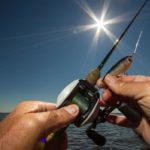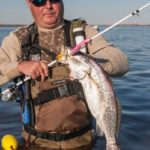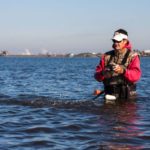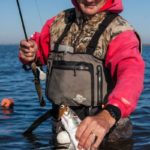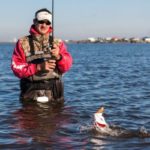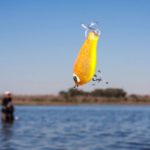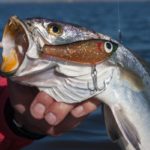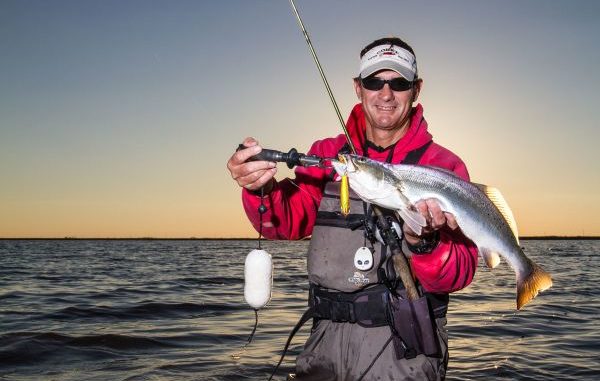
Plenty of trout will be pulled from Big Lake this month, but if you want to catch some really big fish you need to get out of the boat.
I could tell wade-fishing turns Guy Stansel on by the way he jumped into the water. While his buddy Mark Jeanes quietly stepped down the transom ladder into Calcasieu Lake, Stansel leapt in with reckless abandon. The only thing more disturbing to the tranquil environment than the thunderous splash was the resulting cannonball-sized waves that rolled across Joe’s Cove.
Since he had showed me cell-phone pictures of an 8 1/2-pound trout, a 9.3-pound trout and a 7 1/2-pound trout earlier that morning over breakfast at Hackberry Rod & Gun (1-888-762-3391), I understood why he was in a hurry.
Stansel had been tearing up the big trout just days before, and he just knew they were still there.
“I’ve been catching them every trip,” Stansel told me as his rod loaded under the weight of his Corky Fat Boy. “I guess I’ve been in the right place at the right time. I caught the one over 9, two over 8 and probably at least seven or eight over 7 in about a three week stretch — not to mention several 3- to 5-pounders.”
In fact, the only reason Stansel wade-fishes is to catch big fish.
When he is waist deep in the water, nothing else matters.
Granted, we were getting a little farther away from the full moon, and a weather system had moved through the night before, so the big-trout forecast wasn’t on the upswing.
Stansel, Jeanes and I fanned out about 50 yards apart and started combing the flat with identical Corky Fat Boys that had been so productive just days before.
I was the first to break ranks.
I couldn’t help myself. There was a pink MirrOlure She Dog in the small tackle box Stansel had given me to stuff into my wading belt, and she was barking my name.
Within just a few casts, it looked like somebody suddenly flushed the toilet under “pinkalicious,” and I immediately went into why-can’t-I-ever-land-a-topwater-trout mode.
The log of a trout turned toward me and made a run straight at my knees just about the time I finished my mental list of everything that could go wrong.
By the time I caught up with her, she was gone.
Undaunted, Stansel and Jeanes continued casting their Corky Fat Boys.
Jeanes was the next to hook up, but he must have been standing a little too close to me because my run of bad luck seemed to have rubbed off on him.
His trout seemed even bigger than the one I lost, and it popped his monofilament leader on one of its stronger runs.
Two lost trout at least let us know some big fish were still in the cove, but Stansel thought we might want to move up closer to the bank because the tide was rising.
I quizzed Stansel on why he chooses the Corky Fat Boy when wade fishing.
“I like it for a couple reasons,” he said. “Number 1: The thing is heavy, and I can throw it a long way and cover a lot of water. And No. 2: The action imitates a mullet, which is what I think big trout eat.”
Stansel actually employs two different Corky Fat Boys when wade-fishing for big trout. One is a slow sinker, and the other is considered a floater.
“They both sink, though,” Stansel added. “It’s just that the floater sinks slower than the regular Fat Boy. If I’m in knee-deep water, I throw the floater. If it’s thigh to waist deep, I throw the slow sinker.”
After jumping over the side of his boat again, Stansel showed me how he fishes his Corky to get bites that he believes other anglers don’t get.
Rather than fish it on the bottom almost like a “dad-gum bass worm,” Stansel gave it a couple of really hard twitches and took up his slack. Then he hit it hard again.
“I just don’t like fishing it slow,” he noted. “I think I get reaction strikes the way I fish it if they aren’t really feeding. I fish it almost like you would a jerk bait by twitching it so hard — kind of like walking the dog under water with a zigzag pattern.”
Although our largest trout that evening was “only” 5 pounds, Stansel had definitely made the right call by moving closer to the bank.
Trout seemed to be stacked up around crab pots, and I called up three fish to the surface on “pinkalicious.”
The one thing that stood out in my mind about that particular buoy was that a guy in a small boat fished it about 20 minutes before I could finally reach it at the end of a long cast.
That got me to wondering why so many anglers at Calcasieu Lake catch big trout when wading as opposed to drifting in a boat.
“I think it’s because you can cover an area so much better when you’re in the water with the fish,” Stansel explained. “When you’re in a boat, you drift through there just like that guy did and make maybe 10 or 20 casts through a flat. If you’re wading, you’re making a couple hundred casts in that same stretch.”
Some folks think it has more to do with the lack of noise, but Stansel has landed too many big trout out of a boat to side with that argument.
He boiled it down to the fact that you fish more when you’re wading rather than boat riding when you’re drifting.
With so much more time with his bait in the water, Stansel said wading increases his chances of putting it in front of a big trout when it happens to swim by.
“You got those three bites all by that one crab pot, but I don’t think those fish were just sitting there waiting,” Stansel said. “I think big trout are always on the move to and from a hot spot where they might be feeding.
“That pot just happened to be the spot.”
In fact, Stansel believes big trout swim right along with the mullet; he’s seen trout swimming by mullet right beside him, but he couldn’t make them bite.
Take those same trout following those same mullet out farther away from you where you can make the perfect cast at the right moment, and you can catch those fish.
“Long casts are important, but not because you stand a better chance of getting them to bite farther away from your legs,” Stansel said. “They’re important because they allow you to cover so much more water.”
Stansel estimates that he has caught maybe five or six trout within 10 feet of him in all his years of wade-fishing. However, he believes this has more to do with his giving up on a cast at 20 feet rather than the fish getting spooky beside him.
“It just seems like more often than not I get my best bites way out at the end of a long cast,” he said. “That’s why I fish with a full spool of 20-pound-test PowerPro braided line on a Shimano reel with only one break engaged.”
He even oils that one engaged brake to make it stay loose.
It’s a recipe for a backlash, but an educated thumb and years of experience allowed him to cast his lures at least 20 feet past mine.
“You’ve really got to ride your thumb heavy to keep it from backlashing, but it’s not that hard to get used to it,” he said. “Once you get it right, you can throw that Corky a really long way.”
Stansel wrapped up by pointing out a few good spots for April wade fishermen to try. His first choices were the west and east side of Turner’s Bay. The west side is a big flat, and there is a big reef on the east side.
“The north end of the lake tends to be the best place for wading because it has more big, shallow flats,” he said. “Then you can go down to the big flat at Long Point, the south bank by Grand Bayou — but it gets really deep really quickly over there — and the east bank of West Cove. That’s probably the easiest walking place there is because it’s hard like concrete a little farther north up that bank.”
No matter where you go this April, odds are you won’t find Stansel wading. Even though it’s his favorite way to fish for big trout, business is in full swing at Hackberry Rod & Gun, so he spends a lot more time drift fishing than wading.
But on the off chance that he does get a free day, you can bet he’ll jump in the water o get his jollies waist deep in trout.

